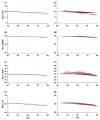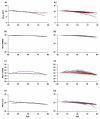Longitudinal modeling of age-related memory decline and the APOE epsilon4 effect
- PMID: 19605830
- PMCID: PMC2928998
- DOI: 10.1056/NEJMoa0809437
Longitudinal modeling of age-related memory decline and the APOE epsilon4 effect
Abstract
Background: The APOE epsilon4 allele is associated with the risk of late-onset Alzheimer's disease. The age at which memory decline diverges among persons who are homozygous for the APOE epsilon4 allele, those who are heterozygous for the allele, and noncarriers is unknown.
Methods: Using local advertisements, we recruited cognitively normal subjects between the ages of 21 and 97 years, who were grouped according to their APOE epsilon4 status. We then followed the subjects with longitudinal neuropsychological testing. Anyone in whom mild cognitive impairment or dementia developed during follow-up was excluded. We compared the rates of decline in predetermined cognitive measures between carriers and noncarriers of the APOE epsilon4 allele, using a mixed model for longitudinal change with age.
Results: We analyzed 815 subjects: 317 APOE epsilon4 carriers (79 who were homozygous for the APOE epsilon4 allele and 238 who were heterozygous) and 498 noncarriers. Carriers, as compared with noncarriers, were generally younger (mean age, 58.0 vs. 61.4 years; P<0.001) and were followed for a longer period (5.3 vs. 4.7 years, P=0.01), with an equivalent duration of formal education (15.4 years) and proportion of women (69%). Longitudinal decline in memory in carriers began before the age of 60 years and showed greater acceleration than in noncarriers (P=0.03), with a possible allele-dose effect (P=0.008). We observed similar although weaker effects on measures of visuospatial awareness and general mental status.
Conclusions: Age-related memory decline in APOE epsilon4 carriers diverges from that of noncarriers before the age of 60 years, despite ongoing normal clinical status.
2009 Massachusetts Medical Society
Figures


Comment in
-
Age-related memory decline and the APOE epsilon4 effect.N Engl J Med. 2009 Nov 12;361(20):1996; author reply 1996-7. doi: 10.1056/NEJMc091640. N Engl J Med. 2009. PMID: 19907049 No abstract available.
-
Age-related memory decline and the APOE epsilon4 effect.N Engl J Med. 2009 Nov 12;361(20):1996; author reply 1996-7. N Engl J Med. 2009. PMID: 19916243 No abstract available.
References
-
- West RL. An application of prefrontal cortex function theory to cognitive aging. Psychol Bull. 1996;120:272–292. - PubMed
-
- Verhaeghen P, Cerella J. Aging, executive control, and attention: a review of meta-analyses. Neurosci Behav Rev. 2002;26:849–857. - PubMed
-
- Treitz FH, Heyder K, Daum I. Differential course of executive control changes during normal aging. Aging, Neuropsychology, and Cognition. 2007;14:370–393. - PubMed
-
- Petersen RC, Smith GE, Waring SC, Ivnik RJ, Tangalos EG, Kokmen E. Mild cognitive impairment: clinical characterization and outcome. Arch Neurol. 1999;56:303–308. - PubMed
-
- Morris JC, Storandt M, Miller JP, McKeel DW, Price JL, Rubin EH, Bell L. Mild cognitive impairment represents early stage Alzheimer disease. Arch Neurol. 2001;58:397–405. - PubMed
Publication types
MeSH terms
Substances
Grants and funding
LinkOut - more resources
Full Text Sources
Other Literature Sources
Medical
Miscellaneous
